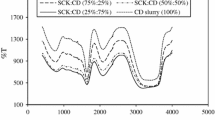Abstract
Electrodialysis (ED) has been proposed as a means to reduce sodium ion concentration in fish sauce. However, no information is so far available on the optimum condition to operate the ED process. Artificial neural network (ANN)-based models were therefore developed to predict the ED performance and changes in selected quality attributes of ED-treated fish sauce; optimum operating condition of the process was then determined via multi-objective optimization using genetic algorithm (MOGA). The optimal ANN models were able to predict the ED performance with R 2 = 0.995, fish sauce basic characteristics with R 2 = 0.992, and the concentrations of total aroma compounds and total amino acids, flavor difference, and saltiness of the treated fish sauce with R 2 = 0.999. Through the use of MOGA, the optimum condition of the ED process was the use of an applied voltage of 6.3 V and the maintenance of the residual salt concentration of the treated fish sauce of 14.3 % (w/w).









Similar content being viewed by others
References
Baker, R. W. (2004). Membrane technology and applications (2nd edition). West Sussex, UK: Wiley.
Belitz, H. D., Grosch, W., & Schieberle, P. (2009). Food chemistry (4th edition). Berlin, Germany: Springer.
Boyaci, İ. H., Sumnu, G., & Sakiyan, O. (2009). Estimation of dielectric properties of cakes based on porosity, moisture content, and formulations using statistical methods and artificial neural networks. Food and Bioprocess Technology, 2, 353–360.
Chen, C. R., & Ramaswamy, H. S. (2002). Modeling and optimization of variable retort temperature (VRT) thermal processing using coupled neural networks and genetic algorithms. Journal of Food Engineering, 53, 209–220.
Chen, C. R., Ramaswamy, H. S., & Alli, I. (2001). Prediction of quality changes during osmo-convective drying of blueberries using neural network models for process optimization. Drying Technology, 19, 507–523.
Chindapan, N., Devahastin, S., & Chiewchan, N. (2009). Electrodialysis desalination of fish sauce: electrodialysis performance and product quality. Journal of Food Science, 74, E363–E371.
Chindapan, N., Devahastin, S., Chiewchan, N., & Sablani, S. S. (2011). Desalination of fish sauce by electrodialysis: effect on selected aroma compounds and amino acid compositions. Journal of Food Science, 76, S451–S457.
Choi, E.-Y., Choi, J.-H., & Moon, S.-H. (2002). An electrodialysis model for determination of the optimal current density. Desalination, 153, 399–404.
Fathi, M., Mohebbi, M., & Razavi, S. M. A. (2011). Effect of osmotic dehydration and air drying on physicochemical properties of dried kiwifruit and modeling of dehydration process using neural network and genetic algorithm. Food and Bioprocess Technology, 4, 1519–1526.
Fazzalari, F. A. (1978). Compilation of odor and taste threshold values data. West Conshohocken, PA: ASTM Data Series DS 48A.
Giri, A., Osako, K., Okamoto, A., & Ohshima, T. (2010). Olfactometric characterization of aroma active compounds in fermented fish paste in comparison with fish sauce, fermented soy paste and sauce products. Food Research International, 43, 1027–1040.
Goncalves, E. C., Minim, L. A., Coimbra, J. S. R., & Minim, V. P. R. (2005). Modeling sterilization process of canned foods using artificial neural networks. Chemical Engineering and Processing, 44, 1269–1276.
Islam, Md. R., Sablani, S. S., & Mujumdar, A. S. (2003). An artificial neural network model for prediction of drying rates. Drying Technology, 21, 1867–1884.
Izadifar, M., & Jahromi, M. Z. (2007). Application of genetic algorithm for optimization of vegetable oil hydrogenation process. Journal of Food Engineering, 78, 1–8.
Jiang, J.-J., Zeng, Q.-X., & Zhu, Z.-W. (2011). Analysis of volatile compounds in traditional Chinese fish sauce (Yu lu). Food and Bioprocess Technology, 4, 266–271.
Kerdpiboon, S., Kerr, W. L., & Devahastin, S. (2006). Neural network prediction of physical property changes of dried carrot as a function of fractal dimension and moisture content. Food Research International, 39, 1110–1118.
Konak, A., Coit, D. W., & Smith, A. E. (2006). Multi-objective optimization using genetic algorithms: a tutorial. Reliability Engineering & System Safety, 91, 992–1007.
Mohebbi, M., Fathi, M., & Shahidi, F. (2011). Genetic algorithm-artificial neural network modeling of moisture and oil content of pretreated fried mushroom. Food and Bioprocess Technology, 4, 603–609.
Sablani, S. S., Baik, O.-D., & Marcotte, M. (2002). Neural networks for predicting thermal conductivity of bakery products. Journal of Food Engineering, 52, 299–304.
Sablani, S. S., Ramaswamy, H. S., Sreekanth, S., & Prasher, S. O. (1997). Neural network modeling of heat transfer to liquid particle mixtures in cans subjected to end-over-end processing. Food Research International, 30, 105–116.
Shihani, N., Kumbhar, B. K., & Kulshreshtha, M. (2006). Modeling of extrusion process using response surface methodology and artificial neural networks. Journal of Engineering Science and Technology, 1, 31–40.
Thai Industrial Standards Institute. (1983). Local fish sauce (pp. 1–30). Bangkok, Thailand: TIS 3-2526.
Tungkawachara, S., Park, J. W., & Choi, Y. J. (2003). Biochemical properties and consumer acceptance of Pacific whiting fish sauce. Journal of Food Science, 68, 855–860.
Youssefi, S., Emam-Djomeh, Z., & Mousavi, S. M. (2009). Comparison of artificial neural network (ANN) and response surface methodology (RSM) in the prediction of quality parameters of spray-dried pomegranate juice. Drying Technology, 27, 910–917.
Acknowledgments
The authors express their sincere appreciation to the Thailand Research Fund (TRF) for supporting the study financially.
Author information
Authors and Affiliations
Corresponding author
Appendix
Appendix
The simple algebraic equations that represent the configurations of three optimal ANN models for the prediction of ED performance and quality of ED-treated fish are listed as follows:
First ANN Model
Second ANN Model
Third ANN Model
Rights and permissions
About this article
Cite this article
Chindapan, N., Sablani, S.S., Chiewchan, N. et al. Modeling and Optimization of Electrodialytic Desalination of Fish Sauce Using Artificial Neural Networks and Genetic Algorithm. Food Bioprocess Technol 6, 2695–2707 (2013). https://doi.org/10.1007/s11947-012-0914-6
Received:
Accepted:
Published:
Issue Date:
DOI: https://doi.org/10.1007/s11947-012-0914-6




